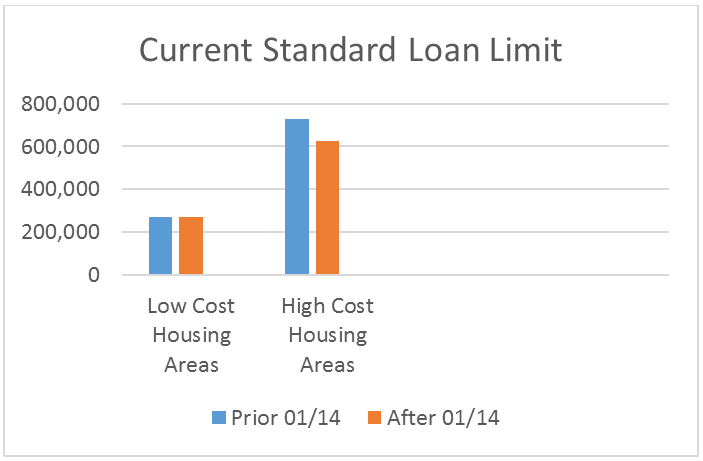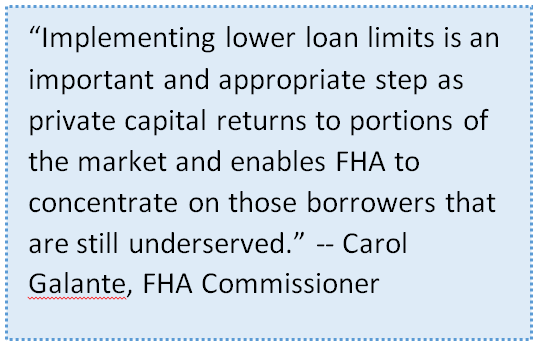The Department of Housing and Urban Development (HUD) made an official announcement that effective January 1, 2014, Federal Housing Administration (FHA) would be lowering lending limits for single-family homes.
The announcement caused much confusion throughout the real estate market and left homeowners with many unanswered questions. Some scrambled to sign-up for questionable time-sensitive offers in order to avoid suffering imaginary penalties and setbacks contemplated by a legally-ordained “golden deadline”.
Still others decided to adopt a wait-and-watch strategy. Unfortunately, a lot of market hype and misinformation have fueled these unfounded fears.
Click here to get today’s rates and the real story on FHA loan limits.
Frantic borrowers have been calling our helpline to determine if they would still qualify for a mortgage loan. In response, we determined that a factual analysis would be more meaningful and beneficial, especially in light of prevailing myths surrounding the announcement.
Correcting a misconception: FHA doesn’t actually make loans
“FHA loans” is a misnomer; FHA-backed loans would be a more accurate description of the program. Contrary to popular belief, the Federal Housing Administration does not offer mortgage loans. Instead, it serves as a government-mandated “equalizer” that serves to insure lenders and minimize the overall risk assumed by lending institutions. FHA-backed loans allow banks to offer home loans for a minimum down payment of 3.5% — even to individuals with low credit scores.

Check today’s FHA rates.
FHA-backed loans have not disappeared
Despite recent limit adjustments, none of the fundamentals change. In fact, the FHA continues to insure loans for millions of borrowers — and may continue to do so in the foreseeable future. The lending limits have been lowered but as we will discuss shortly, it won’t impact the average borrower significantly.
In its official press release, FHA declared that the current standard loan limit for low-cost housing areas will remain unchanged at $271,050. Further, the new national-ceiling loan limit for highest cost areas will be reduced from $729, 750 to $625,500.
Contact us for the FHA loan limit in your area.
The average borrower will not feel the impact of FHA’s new standards
According to the Census Bureau, the median price of US homes is $221,800. As such, most home buyers will not be impacted even at the marginally-lowered lending limits. Even if a borrower is not purchasing a home in this range, the new $625,500 national-ceiling loan limit would still cover the higher-end spectrum of the market. Finally, for multi-million dollar home hunters, jumbo loans are an increasingly popular option.
The private sector is eager to fill the gap; lenders respond with affordable programs
 Lenders don’t want to lose your business and have taken several well-calculated, proactive measures to assist those homebuyers who may be impacted by FHA’s new standards. From jumbo loans to standard mortgage loans, the private sector has introduced several innovative and extremely affordable mortgage programs that would be well-equipped to finance your piece of The American Dream. That is exactly what the FHA hoped to achieve.
Lenders don’t want to lose your business and have taken several well-calculated, proactive measures to assist those homebuyers who may be impacted by FHA’s new standards. From jumbo loans to standard mortgage loans, the private sector has introduced several innovative and extremely affordable mortgage programs that would be well-equipped to finance your piece of The American Dream. That is exactly what the FHA hoped to achieve.
In fact, catalyzing momentum within the private sector and minimizing government involvement appear to be key motivators for the change in FHA’s lending limits. According to FHA Commissioner Carol Galante, “Implementing lower loan limits is an important and appropriate step as private capital returns to portions of the market and enables FHA to concentrate on those borrowers that are still underserved.”
The changes are in line with the initial intent of FHA’s programs. They were conceptualized to provide temporary stability to the housing markets after the 2008 Financial Debacle. Until 2013, Congress renewed them to maintain economic stability and give individuals a chance to purchase homes for a low 3.5% down payment. Given that the market has found its own balance now, the government wants to minimize its involvement and return the strings where they rightly belong in a capitalistic society: The private sector.
Get a personalized FHA rate quote.
Market forces will stabilize high cost areas
FHA lending limits are not a one-size-fits-all model. Much to the contrary, the lending limits tend to accommodate regional variances through highly sophisticated models. The average consumer may not feel much of the impact, but home buyers in “super high” cost areas may see their down payment requirements rise.
What would happen then?
Historic real estate trends provide ample evidence to support the assertion that housing prices may ultimately become more affordable. Theoretically, if the cost of homeownership rises, sellers are forced to accommodate the impact on demand by adjusting prices. Translation: Market forces will stabilize prices in high cost areas and make homes more affordable (and probably in compliance with FHA lending limits).
What happens to the extreme upper echelon of the home buying market?
For individuals seeking extremely high-priced luxury homes, the cost of homeownership may be impacted by higher down payment requirements, stringent credit score criteria, and a greater increase in loan amounts.
Here, buyers may also resort to a 100% privately-financed model, which has become a competitive and viable option in light of recent developments.
Fortunately, the average home buyer does not have to worry about that.
Why wait? Find out your options and whether you qualify for low-cost borrowing options. Click here to complete a short questionnaire and receive an immediate response from our qualified mortgage experts.


